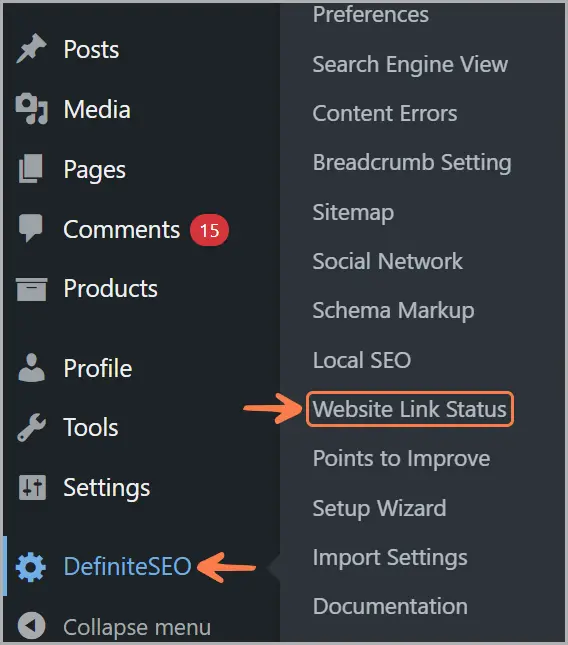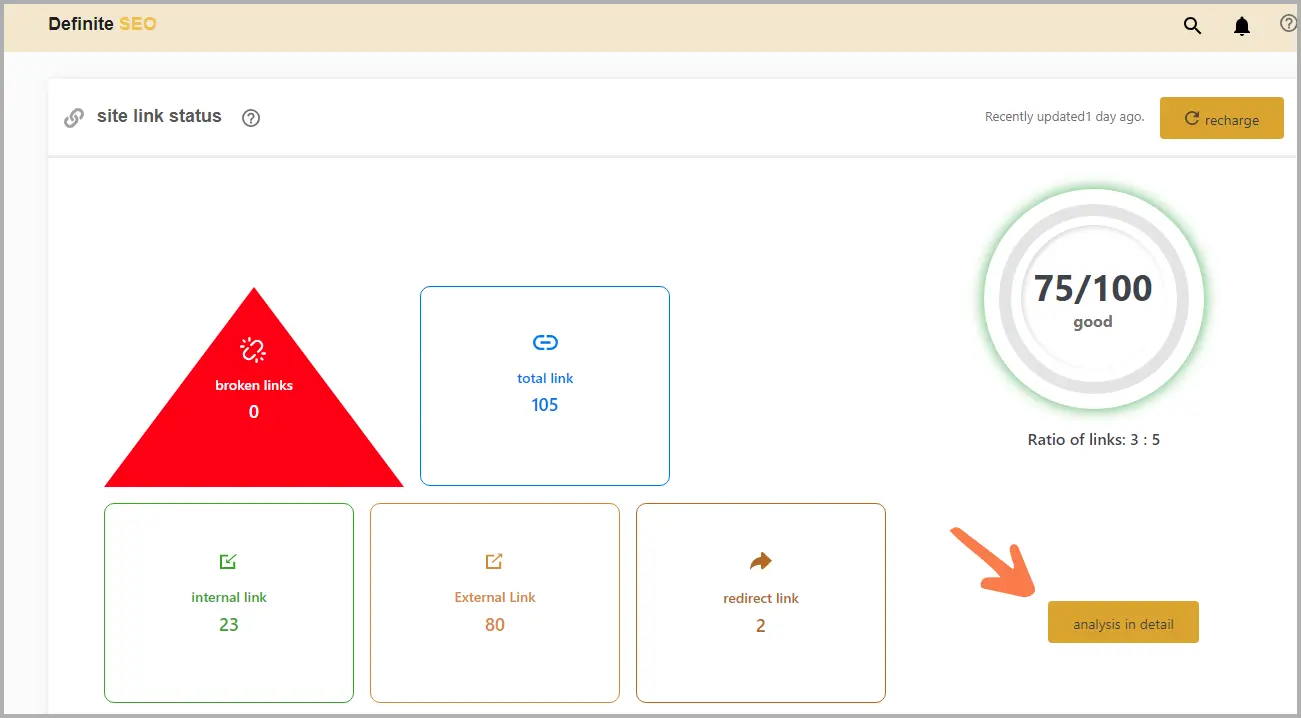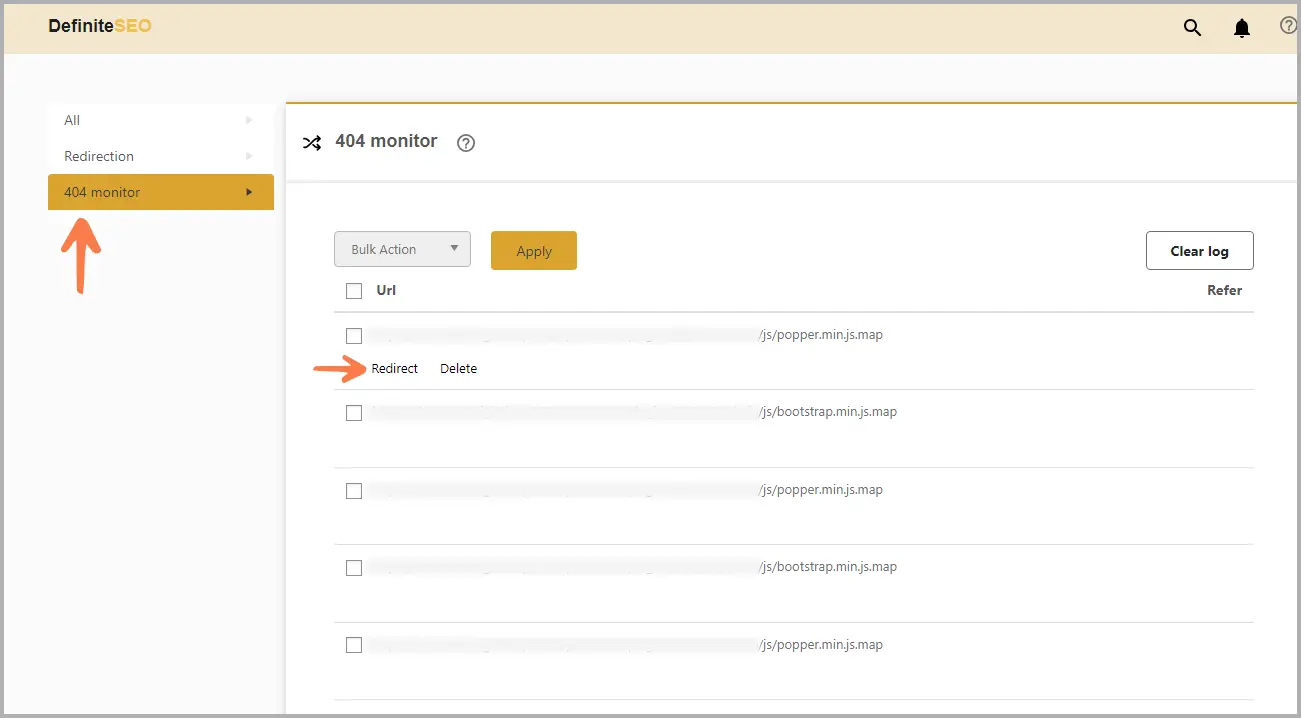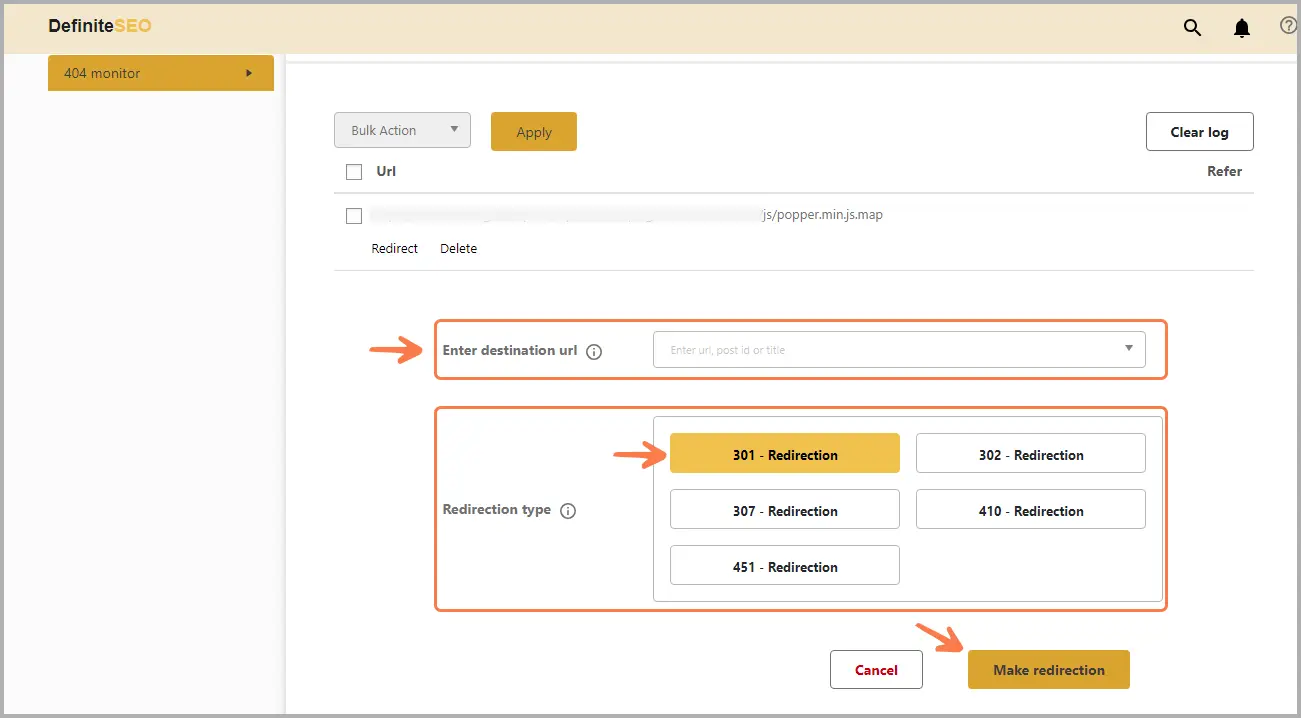Basically it means that the page you have requested and wanted to access are unavailable or not found by the server.
What are 404 Page Not Found Error Pages?
The 404 is an HTTP status code error which means that the page you have requested is either not found, unavailable, or broken. It means the page is either deleted, moved, or removed from the website or it was not there at all. Usually, when a user requests a page that does not exist anymore, the HTTP server responds with a ‘Page not found’ response.
Typically the 404 error means ‘page not found’ which means the page requested by the user was not found on the server for some reason. This also means that either you can lose a lot of visitors, or you have a chance of getting them back on track.
Fortunately, with the help of the Definite SEO it is easy to monitor 404 error pages and redirect them to an lternative working page. In this article, I am going to discuss in detail how to monitor this error and fix it with redirects. So, let’s begin.
How to Find and Fix 404 Errors Using Definite SEO?
You can easily find and monitor 404 errors on your WordPress website using the Definite SEO. The plugin shows you all the URLs that have the 404 error and you need to redirect to.
Step 1:

Under Definite SEO select Website Link Status
Step 2:

Here you will see all the details of your website links, now go to Analyze in Detail
Step 3:

Go to 404 Monitor
Step 4:

Now you can set the redirects here, thus you can redirect any page with 404 error. Simply, add the “destination URL”. Here is what you need to do:
- First of all, install and activate the plugin on your WordPress website. Then on the dashboard under Definite SEO settings you will find “Website Link Status” option.
- Next, go to the “404 monitor” option.
- Now click Redirect on any url than select the type of redirection you want to apply.
Types of Redirections
Definite SEO allows you to select various types of redirects here. We have 5 types of redirects to use for various purposes.
- 301 Redirection: A 301 redirect should be used when the page has been moved permanently. You should be using this redirect if you have no intention to revive your old page.
- 302 Redirection: A 302 is a temporary redirect. You can use this redirect if you want to send users and search engines to another URL for some time or as long as it is needed. For example, if you are redesigning the About Us page of your website then you might want to redirect the users from the About Us page to another page. Here 302 redirects can be used effectively.
- 307 Redirection: The 307 redirect means that the resource request has been temporarily moved to another URL. 307 is a specific version of error 302.
- 410 Redirection: The 410 status code is used to tell the users that the page is “Gone”. It means that the page is not available anymore but it existed in past and it will not be coming back at any time in future. Similarly, for the search engines, it means that the crawlers do not need to come back, again to crawl and index and check if the page has returned or not.
- 451 Redirection: The 451 failed error response code means that the URL has been deleted because of legal reasons.
The ‘404 error’ can be seen in different ways by different Web Browsers:
- 404 error
- 404 page not found
- 404 not found
- Error 404
- HTTP 404 error
- The requested URL was not found on the server
- Error 404 not found
- HTTP 404 not found
- Error 404. The page you are looking for cannot be found.
These are just a few examples of you may appear, however, the format may vary depending on the web browser. When it comes to Search Engine Optimization, monitoring and managing 404 errors is crucial. Simply because 404 errors can affect the traffic and also the search engine ranking of a website.
And from the user’s perspective. ‘Page not found is one of the most frustrating things to find on the web. Aside from creating a bad user experience, a higher bounce rate because of broken links affects the SEO ranking.
So, to fix this issue, you need to apply redirects, which will redirect all of the link juice and traffic from the 404 error page to another page that is relevant and correct. So by adding redirects to these pages, you can easily overcome 404 errors, and not hurt the SEO of your website. You can use seo checker for detail report of your site. You may also read about importance of internal links in SEO, add breadcrumbs in WordPress and SEO benefits of keyword in url.
What Causes 404 Errors?
Typically, 404 originates from your CMS, which can occur because of multiple reasons. Although the format for the 404 error varies depending upon the browser and operating system. However, the causes of this error are mostly the same. Here are some of the reasons why you may come across HTTP 404:
-
The Page has been Moved
It is a common practice to move web pages from one slug to another. For instance, you may want to reorder or restructure your website and move a page from one section to another. Else you may want to update the permalink of a page, which means the URL of the page is changed.
Whatever it is, if the user looks for the old URL or the original address which no longer exists, it will show a 404 error to the user, unless the server directs visitor to another URL. -
The Page is Deleted from the Site
- One of the most common causes of the 404 error is if the page has been deleted from the website. Simply because the page was found on the site but has been deleted now. This can be because the website doesn’t require this page anymore or may the page was removed accidentally. Likewise, the page does not exist anymore which is why it shows the 404 error.Quick Tip: To avoid such errors in the first place, you must check the links that point to such pages, before deleting the page. If links are pointing to the deleted page, then you need to search for the links and redirect them to the related pages. This will help you in directing the traffic from 404 pages to a relevant one.
-
The Domain Name Doesn’t Exist Anymore
This one’s pretty straightforward as well! If a page the user is trying to access is on a domain that no longer exists, the server will not be able to find it for obvious reasons. So, if you move your website to a new domain it is important to add 301 redirects. How? I will discuss this in detail later in this article.
Adding 301 redirect lets the users and the search engines know that the URL address they have requested has been moved to a new one, and also directs them there. If you do not use 301 redirects while moving your site, not only will it result in a bad user experience but also drive the traffic away from your site.
-
The Typed URL is Incorrect
This one’s self-explanatory. So, if the user types the URL on a browser incorrectly, something that does not exist, the server will show a 404 ‘Page not found error. Here are a few common mistakes that you may carry out so make sure to check when you type the URL:
- Use upper case in case the URL is written in lowercase.
- Adding or deleting the trailing slash at the end of the URL.
- Adding space in the URL when not needed.
- Using underscore when the URL has (-) instead.
- And so on.
If there are any mistakes in the URL address the server will display 404 not found errors. You have no control if a visitor types an incorrect domain name but in case there is a typo in the page or post url you can handle it.
Quick Tip: To avoid 404 errors because of typing mistakes, make sure the permalinks are user-friendly and not confusing. Here are quick suggestions that you need to follow:
- Try to keep the URLs short (between one to five words is ideal).
- Use lowercase because the use of uppercase in URL is most likely to result in typing mistakes.
- Try to make the URLs easy to remember and obvious.
- Use (-) as a separator. Using dashes between the words makes the URL more readable and less likely to commit mistakes.
-
Server-Side Error
A server-side error occurs when the server hosting your website is not working, or the connection is broken. This may also happen if you move your website to a new host. And the DNS servers are yet to direct completely.
In simple words, the DNS for a few users may temporarily point to the old host provider, but since the website has been moved to a new host it may show an HTTP 404 error.
While most of the web hosts will try their best to not let this happen, in very few cases this might occur.
Quick Tip: When you migrate your website to a new host, it is best to move the site at a time when the traffic is minimum to reduce the downtime.
How to Fix 404 Errors on WordPress Site?
It is common to have 404 errors on a website, however, you cannot leave them just like that as it would affect the SEO ranking. That being said, having a few broken links is nothing to worry about. However, you must keep a track of these errors and fix them. It is important to fix the errors as promptly as you can to avoid losing out on the traffic as well as ranking.
Now, let’s see how you can fix the ‘404 Page Not Found error:
-
Redirecting the Page
One of the easiest ways to fix the 404 errors is by redirecting the old URL to the new one. You can do so by using 301 redirects.
-
Check the Link
Many times the 404 error may occur because of typing errors or mistakes. Sometimes you may have incorrectly typed the URL while putting links in content. If this is what is causing the 404 error then you would want to fix the mistake in the URL, and automatically the error will be resolved.
-
Restore or Replace the Deleted Pages
In some cases, the users will come back looking for pages that no longer exist and have been deleted. Just because the page has been deleted from a site people still might come looking for it. Else the users may land on the deleted pages through external links. To fix this issue you can restore or replace the deleted pages. Otherwise, you can redirect the pages that have been deleted from the site to the sites that have a similar intent and are relevant.
-
Incorrect Link on a Third Party website
If your page link is incorrect of a third party website you can contact the website owner and can request him/her for link correction.
Does 404 Error Affect SEO Ranking and Usability of a Site?
When search engines try to access a web page but the server response shows a 404 error then it does not create a good impression on them. Once the web crawlers find 404 error codes on a site, they conclude that the website is not well maintained as it is not performing well. Broken links, inaccessible pages, and errors decline the effect of a website and its ability to rank on the SERPs. Besides, this can result in a substantial decrease in the number of visitors too.
In case your website has many broken links that lead to 404 errors, as a result, it will also lower the number of visitors to the site. Moreover, if the website experiences this problem frequently the users might not even pay attention to visiting the site again.
Custom 404 Page
Having a custom 404 page is much better than having nothing. You can be sure that the users are receiving the HTTP status code. On the other hand, you can customize it further to create a better user experience for the visitors. Here are a few things that you need to include in the 404 error message.
-
Only Use the 404 HTTP Status Code
While customizing the page make sure the page returns to 404 HTTP response code and not 200 OK.
-
Keep the Content Short and Simple
Make sure the 404 error message you display is clear and simple. Try to write in a friendly way and also be apologetic. You can also let your visitors know what happened and ask the visitors to check the URL they have entered in case it is incorrect.
-
Design the 404 Quite Similar to your Website
Customize the 404 error page just like the rest of the website design to keep it more relatable. Keep the navigation menu, fonts, colour and other elements similar to your website.
-
Ask the User to Take the Action
To avoid users leaving the website ask them to take an action instead. Add elements to the 404 page that allow the users to take an action. You can add a link to your homepage, or any other related working page on the site. You can also add a search option on the page.
Conclusion
The redirections allow you to direct users as well as the search engines to another URL than the one that has been requested. If you place the redirects correctly it can be extremely beneficial from an SEO point of view.
Whenever you audit your website, you might delete, or update the page on the website. If you have changed any of the URLs on your website or have deleted any of the web pages then redirections are a must. The 301 redirect with Definite SEO allows you to set correct redirection, any time you move a site to a new domain, or delete the page, without affecting the SEO performance. This way you can also avoid 404 errors, which again affect the ranking of your website.
FAQs
Q. Is 301 redirect permanent?
Yes, 301 redirect permanently moves the link to the redirected page. So, you can use the redirect if the page or URL is never coming back.
Q. When should I use 301 redirects?
There are several use cases of 301 redirects. However, here are some of the most common reasons why you may have to use a 301 redirect on your site.
- Changing or moving an old page to a new one.
- Rebuilding your WordPress website structure.
- You have a page or content that is no longer live on the site, so you need to redirect users to a new page.
Q. Why are my redirects not working?
There can be several reasons why your redirects are not working. However, make sure you have redirected the old page to the correct URL. Make sure to check common mistakes like slashes, spaces, spellings, and invalid characters. If the URL seems to be correct, then try clearing the cache of your browser, and then check if the redirects are working fine now. You can also test your redirects in an onlike redirect checker tool.
Q. How can 301 redirect affect SEO?
Once you implement 301 redirect it will not affect the link juice as it passes most of the link equity to the redirected URL. For a permanent change, using a 301 redirect is important as it will not drastically affect your site’s SEO ranking.
Q. Is there any situation where you should not use 301 redirects?
Yes, in situations where you have to move the content temporarily, instead of using 301 redirects you need to use 302 redirects. Here are some possible reasons why you should not use 301 redirects:
- If you want the search engines to keep indexing the original URL.
- Run A/B testing with the URL.
- You need to redirect for site maintenance or upgrades.